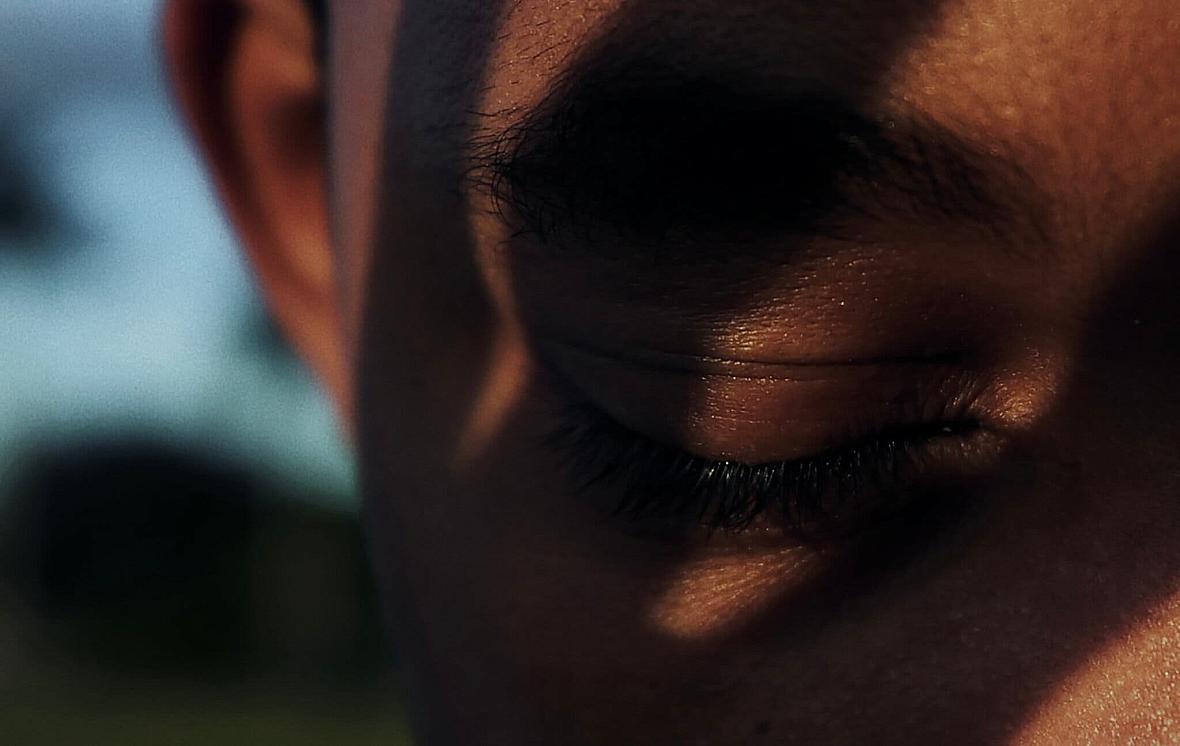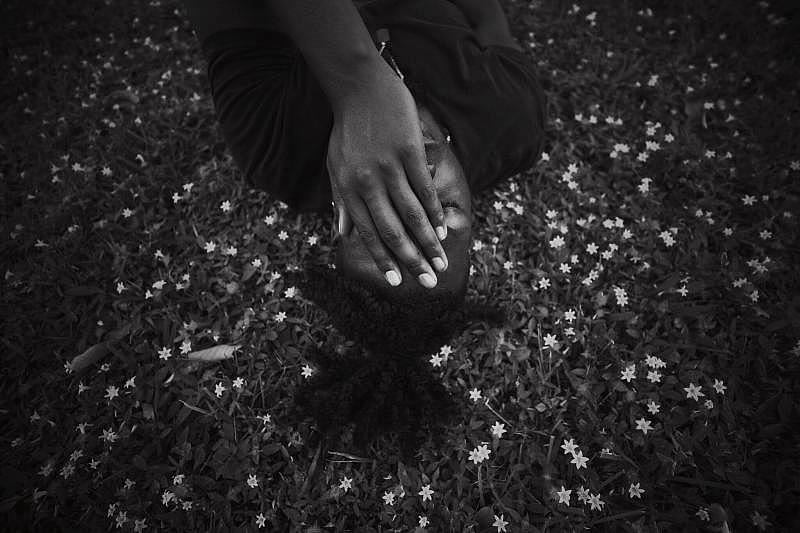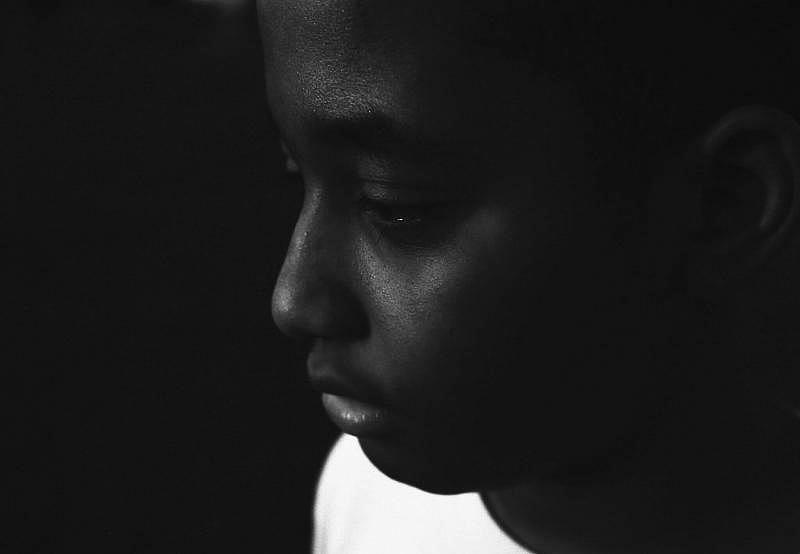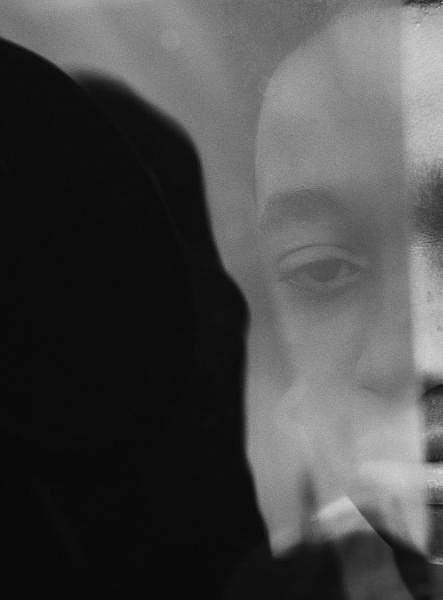Why are more Black kids suicidal? A search for answers.
This article was produced as part of the USC Annenberg Center for Health Journalism’s 2021 National Fellowship.

Photographs by Julien James
Joe was 17 when he decided life wasn’t worth living.
He was tired of the violence in his Boston neighborhood, where his older brother had spent more than a year recovering from a gunshot wound to his leg. And he was especially tired of the comments about his weight.
“You think you can sit on that chair?” his classmates would ask.
Other times they were more direct, saying simply: “You’re fat.”
“Sometimes I’d be so depressed I wouldn’t eat for three days,” said Joe, now 25, who was a lineman on his high school’s football team.
(Joe’s surname and that of another young person interviewed for this article are being withheld to protect their privacy. Joe is being identified by his middle name.)
He thought about ending his life if the bullying didn’t stop. Those thoughts eventually became so pervasive that one day he came home from school and took a small handful of pills. But it was enough only to produce a bad stomachache.
Months later, he was still feeling depressed. “Let me go see a therapist. My head’s not right,” he told his father. “I’m having these thoughts of killing myself — that you’d all be better without me here.”
Joe still remembers his father’s response: “That’s not true. We love you. But you want to talk to somebody and tell someone that? They’re going to think you’re crazy.”
Over the past generation, a mental health crisis has been brewing among Black youths like Joe, one that very few people — including Black families — have spoken about publicly. Self-reported suicide attempts rose nearly 80 percent among Black adolescents from 1991 to 2019, while the prevalence of attempts did not change significantly among those of other races and ethnicities. Legislators and academics are now pushing for better research to understand why, especially in light of new evidence that suggests Black children may have unique risk factors for self-harm.
‘I Didn’t Necessarily Want to Die’
One study of high school students, published in September, found that the Black teenagers surveyed were more likely than the white teenagers to have attempted suicide without first having suicidal thoughts or plans. Because suicide screening questionnaires typically ask whether people are having suicidal thoughts or have made plans to hurt themselves, the authors speculated that the questionnaires might fail to identify some Black youths who are at risk of suicide, or that there could be additional factors that might indicate a need for intervention.
More research is needed, but a government study conducted last year suggested that Black children and adolescents who died by suicide were more likely than white youths to have experienced a crisis in the two weeks before they died. They were also more likely to have had a family relationship problem, argument or conflict, or a history of suicide attempts.
Jordan Burnham, who survived a jump from a ninth-story window when he was 18, said that if he had been asked whether he was planning to kill himself that day, the answer would have been no.
“I couldn’t even think that far ahead,” he said.
Photographs by Julien James
The fall broke his pelvis, shattered his left leg and fractured his wrist, skull and jaw. It would be four years before he could walk again.
“I didn’t necessarily want to die,” added Mr. Burnham, who is now 32 and visits as many as 60 schools a year to speak about suicide prevention and mental illness. “But the part of me that had depression and shame and sadness everyday — I wanted that pain to die. I wanted that part to go away.”
On the day of his suicide attempt, he was confronted by his parents about a stash of alcohol that they had found in his car. Although Mr. Burnham was diagnosed with depression as a teenager, he became so good at hiding it that even his own family members, who were loving and supportive, did not fully understand how much pain he held inside — or the extent to which he felt like an outsider as one of the few Black students at a mostly white school in suburban Philadelphia.
Suicide and mental illness are often thought of as a “white phenomenon,” said Michael A. Lindsey, the executive director of the McSilver Institute for Poverty Policy and Research at New York University, who studies the mental health of Black adolescents.
Looking at the raw numbers, it’s easy to understand why. White deaths by suicide far outnumber those of Black people. But when taking into account youth suicide rates — the number of suicides per 100,000 individuals under age 25 — a different picture emerges.
“I think the statistics are shocking,” said Dr. Lindsey, who was the first to document trends in rising suicide attempts among Black adolescents.
A 2018 study found that while the suicide rate of Black children 5 to 12 was low, it was nearly twice that of white children in the same age group. In one of the most recent examples, a 10-year-old Black girl with autism died by suicide in Utah in early November. Her parents said she had been subjected to racist bullying by her classmates.
Among teenagers and young adults, suicide rates remain highest among whites, Native Americans and Alaska Natives. But while the suicide rate has recently declined among those groups, it has continued to rise among Black youths. From 2013 to 2019 the suicide rate of Black boys and men 15 to 24 years old rose by 47 percent, and by 59 percent for Black girls and women of the same age.
Adolescents of color who identify as L.G.B.T.Q. may be especially at risk of a suicide attempt, according to a national survey conducted by the Trevor Project, a suicide prevention group for L.G.B.T.Q. youth.
Despite the racial disparities — and the fact that suicide is the second leading cause of death among all adolescents — there has been a dearth of research examining the racial and ethnic differences in youth suicidal ideation, plans or suicide attempts.

Photographs by Julien James
“You have to bring culture into this, you have to talk about racism, you have to talk about discrimination,” said Arielle Sheftall, a principal investigator at the Center for Suicide Prevention and Research at Nationwide Children’s Hospital in Columbus, Ohio. “It is something that Black youth experience every single day.”
A report presented to Congress in 2019 identified gaps in research and policy and has resulted in more research dollars flowing to studies related to Black youth suicide, including a program to teach middle schoolers about mental health and a suicide prevention intervention called Success Over Stress, which touches on themes like systemic racism and police brutality to help ninth-grade students at predominantly Black schools develop coping skills.
“These kids have stressors that are uniquely different than other kids,” said LaVome Robinson, the lead investigator of the Success Over Stress study and a professor of psychology at DePaul University in Chicago.
‘Nothing to Stress About’
Deaths by suicide are more common among boys than girls overall, but a study published in September found that suicide rates among Black girls increased by an average of 6.6 percent each year from 2003 to 2017 — more than twice the increase for Black boys. A diagnosis of depression or anxiety was more common among the girls. Additionally, nearly 20 percent of the girls had engaged in an argument within 24 hours of their deaths.
Denise (her middle name), 19, a high school senior in Cleveland, lives with her mother and six siblings. She struggles with depression and anxiety, largely driven by conflict at home and the lingering trauma of a sexual assault.
“When I told Mom how I was feeling, she didn’t seem to care,” Denise said, adding: “She said I had nothing to stress about because I’m a kid.”
“I just felt like there was nothing nobody could do to change the situation.”
One evening in September, after a disagreement with her mother, she texted one of her school counselors and told her: “I don’t want to be here no more.”
Her counselor insisted that she go to the hospital to get a psychiatric evaluation.
“The first three nights I spent in the hospital, all I could do is cry,” said Denise, who received her first prescription for psychiatric medication while she was there. “I just felt relieved that somebody could actually understand what I’m going through. It felt good to let it all out after holding it in for so long.”
Suicidal behavior is already a well-known problem in Denise’s school district, which is about two-thirds Black. In 2019, data from the Centers for Disease Control and Prevention showed that 18 percent of Cleveland high school students had attempted suicide in the previous 12 months, compared with about 9 percent nationally. Many students in Cleveland face chronic stressors, including neighborhood violence and food insecurity. Researchers have found that young people are more likely to die by suicide in high-poverty communities.
Photographs by Julien James
Lisa Ellis, a counselor at a high school in Cleveland, developed an eight-week program for first-year students at her school that aims to help reduce the stigma of mental illness, which she sees as a large barrier preventing students of color from getting the help they need.
The curriculum includes videos, like TED talks about mental health, as well as discussions about various mental health diagnoses and healthy coping mechanisms to help students regulate their emotions inside and outside the classroom.
‘Keeping Your Business Out of the Street’
An American Psychological Association report found that only 4 percent of psychologists in the United States in 2015 were Black, even though Black people represent 13 percent of the population. A similar disparity exists among social workers and psychiatrists.
“This is a deterrent,” said Dr. Kali D. Cyrus, a psychiatrist at Sibley Memorial Hospital in Washington, D.C., and an assistant professor at Johns Hopkins University. Talking about your family’s business with a white person — much less an outsider — is often discouraged in the Black community, added Dr. Cyrus, who is Black.
Most mental health care for children takes place in public schools via school psychologists or counselors. This is especially true in low-income districts where other resources are scarce. But these professionals are also in short supply.
Even when mental health professionals are available, research has shown that Black adolescents’ depression often goes untreated because of negative perceptions of services and providers or feelings of shame about experiencing depressive symptoms.
“Black families don’t typically have literacy in discussing ‘feelings’ with each other,” Dr. Cyrus said in an email. “There is also the strong value of ‘keeping your business out of the street.’”
Ever since Kathy Williams’s teenage son Torian Graves took his life in 1996, she has been teaching the people in her hometown, Durham, N.C., about the symptoms she missed and the importance of mental health treatment. But the stigma is still strong, she said. Some parents are afraid of being judged and don’t trust therapists. Sometimes they say: “Just pray about it. It will go away.”
Yes, she said, prayer is good. But treating mental illness requires more than that.
After her son died, she found a poem in his room that he had written as a class assignment.
It reads:
Part of me is Carolina Blue,
Full of Flavor and Excitement,
Like a Wild Rollercoaster
On the Loose.
But, At times,
I’m mean, dark, lonely,
Black, mad at the world,
Like a lost dog in the desert,
Yet, they are both true,
And they are both me.
“Wow, this is the way my child was feeling,” she recalled thinking at the time.
“I saw him angry at times and couldn’t figure out why,” she said of her son, who was 15 when he died. “I believe Torian was depressed and we didn’t know it.”
To help remove the stigma associated with therapy, Dr. Lindsey has developed a pilot program at five New York City public middle and high schools that recruits Black youths who are experiencing symptoms of depression and enrolls them in therapy with a clinician at a school-based mental health clinic.
When parents are informed that their children have mental health challenges, they often feel as if they did something wrong, Dr. Lindsey said.
“The first thing we tell them is this is not your fault, this is not the result of bad parenting,” he added.
As for Joe, who had been struggling with depression in Boston, he did eventually find a therapist with the help of his mother and his primary care doctor, and started therapy at the beginning of 12th grade.
“Talking to someone every Wednesday for one hour, it just did something,” he said. “It made me feel like a person, like I was wanted.”
His father and the rest of his family noticed that he wasn’t as angry anymore.
“It’s not that I was crazy,” Joe said. “I needed someone to understand what I was going through, to give me a way to deal with it.
Now, Joe said, “I love who I am.”
If you’re worried about someone in your life and unsure of how to help, use one of these free, 24-7 resources:
The National Suicide Prevention Lifeline: 1-800-273-8255 (TALK)
The Crisis Text Line: Text TALK to 741741
The American Foundation for Suicide Prevention
This article was produced as part of the USC Annenberg Center for Health Journalism’s 2021 National Fellowship.
[This story was originally published by The New York Times.]

